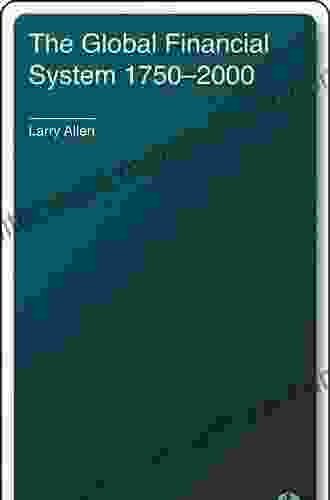The Evolution of the Global Financial System, 1750-2000: A Journey of Interconnectedness and Complexity

The global financial system has undergone a remarkable transformation over the centuries, from its humble beginnings in local markets to its current state as a highly interconnected and complex network spanning the globe. This intricate web of financial institutions, markets, and instruments has played a pivotal role in facilitating economic growth, trade, and investment worldwide.
4 out of 5
| Language | : | English |
| File size | : | 924 KB |
| Text-to-Speech | : | Enabled |
| Screen Reader | : | Supported |
| Enhanced typesetting | : | Enabled |
| Word Wise | : | Enabled |
| Print length | : | 296 pages |
In this article, we embark on a journey to explore the evolution of the global financial system from 1750 to 2000. We will delve into the historical events, economic theories, and technological advancements that shaped its transformative development. By tracing the interconnectedness and complexity that have characterized the system over time, we gain a deeper understanding of its impact on economic growth and global economic stability.
The Rise of the Global Financial System, 1750-1870
The origins of the modern global financial system can be traced back to the mid-18th century with the rise of merchant capitalism and the Industrial Revolution. Expanding trade and commerce fostered the emergence of financial institutions such as banks, insurance companies, and stock exchanges. These institutions played a crucial role in mobilizing capital, facilitating payments, and managing risk, thereby creating a more liquid and efficient financial market.
The Industrial Revolution, with its burgeoning manufacturing and technological advancements, further fueled the demand for capital and financial services. The issuance of bonds and stocks provided a means for businesses to raise funds for expansion and innovation, while the development of new financial instruments, such as options and futures, allowed investors to manage risk and hedge against uncertainty.
The Integration of Financial Markets, 1870-1914
The latter half of the 19th century witnessed a rapid integration of financial markets on a global scale. Advances in communication and transportation technologies, such as the telegraph and steamship, facilitated the flow of information and capital across borders. The establishment of the gold standard, which pegged the value of currencies to gold, provided a stable monetary framework that encouraged international trade and investment.
During this period, financial centers emerged in major cities such as London, Paris, and New York, serving as hubs for international banking and finance. The development of international capital markets allowed governments and businesses to borrow funds from abroad, fueling economic growth and globalization.
The Interwar Period and the Rise of Central Banking, 1914-1945
The outbreak of World War I in 1914 disrupted international financial markets and led to economic turmoil. The gold standard was abandoned, and countries resorted to inflationary monetary policies to finance war expenses. The interwar period was characterized by financial instability and currency fluctuations.
In response to these challenges, the concept of central banking emerged. Central banks were established to manage monetary policy, control inflation, and maintain stable financial conditions. The Federal Reserve System in the United States, founded in 1913, served as a model for central banks around the world.
The Bretton Woods System and Post-War Reconstruction, 1945-1971
After the devastation of World War II, the Allied powers met at Bretton Woods, New Hampshire, in 1944 to establish a new international financial system. The Bretton Woods system re-established the gold standard and created the International Monetary Fund (IMF) and the World Bank to promote monetary stability and facilitate economic development.
The post-war period witnessed significant economic growth and financial integration. The Marshall Plan, a massive aid program from the United States, helped rebuild Europe's war-torn economies. The General Agreement on Tariffs and Trade (GATT),established in 1947, promoted free trade and reduced barriers to international commerce.
The Rise of Petrodollars and Global Financial Instability, 1971-1990
The Bretton Woods system began to unravel in the 1970s due to inflationary pressures and imbalances in the global economy. The United States abandoned the gold standard in 1971, leading to a period of floating exchange rates and increased volatility in currency markets.
The oil crisis of 1973 had a profound impact on the global financial system. The sharp increase in oil prices led to a transfer of wealth to oil-exporting countries, creating a surplus of petrodollars. These petrodollars were recycled through the international financial system, contributing to global inflation and financial instability.
Globalization and Financial Deregulation, 1990-2000
The fall of the Soviet Union in 1991 marked the beginning of a new era of globalization. The spread of free market principles, technological advancements, and the liberalization of trade and capital flows led to an unprecedented expansion of the global financial system.
Financial deregulation, particularly in the United States, played a significant role in this expansion. The repeal of Glass-Steagall in 1999, which separated commercial and investment banking, paved the way for the creation of massive financial institutions with diverse and complex operations.
The Global Financial Crisis of 2008 and Its Aftermath
The global financial system faced its most severe challenge since the Great Depression in 2008. The subprime mortgage crisis in the United States triggered a chain reaction of events that culminated in the collapse of major financial institutions and a deep global recession.
The crisis exposed the weaknesses and systemic risks within the global financial system, leading to a reassessment of regulatory frameworks and financial practices. Governments and central banks around the world implemented stimulus measures and tightened financial regulations to prevent future crises.
The evolution of the global financial system from 1750 to 2000 is a story of interconnectedness, complexity, and constant adaptation to changing economic and technological landscapes. From its humble beginnings in local markets to its current state as a highly integrated network, the global financial system has played a pivotal role in facilitating economic growth, trade, and investment.
As we look ahead, the global financial system faces new challenges and opportunities. Technological advancements, such as blockchain and artificial intelligence, are transforming financial services and creating new possibilities. The growing interconnectedness of the global economy requires continued cooperation and coordination among nations to ensure the stability and resilience of the financial system.
Understanding the evolution of the global financial system is essential for policymakers, economists, and anyone interested in the intricate workings of the global economy. By studying the historical precedents and the lessons learned from past crises, we can better prepare for the challenges and reap the benefits of this dynamic and ever-evolving system.
4 out of 5
| Language | : | English |
| File size | : | 924 KB |
| Text-to-Speech | : | Enabled |
| Screen Reader | : | Supported |
| Enhanced typesetting | : | Enabled |
| Word Wise | : | Enabled |
| Print length | : | 296 pages |
Do you want to contribute by writing guest posts on this blog?
Please contact us and send us a resume of previous articles that you have written.
 Top Book
Top Book Novel
Novel Fiction
Fiction Nonfiction
Nonfiction Literature
Literature Paperback
Paperback Hardcover
Hardcover E-book
E-book Audiobook
Audiobook Bestseller
Bestseller Classic
Classic Mystery
Mystery Thriller
Thriller Romance
Romance Fantasy
Fantasy Science Fiction
Science Fiction Biography
Biography Memoir
Memoir Autobiography
Autobiography Poetry
Poetry Drama
Drama Historical Fiction
Historical Fiction Self-help
Self-help Young Adult
Young Adult Childrens Books
Childrens Books Graphic Novel
Graphic Novel Anthology
Anthology Series
Series Encyclopedia
Encyclopedia Reference
Reference Guidebook
Guidebook Textbook
Textbook Workbook
Workbook Journal
Journal Diary
Diary Manuscript
Manuscript Folio
Folio Pulp Fiction
Pulp Fiction Short Stories
Short Stories Fairy Tales
Fairy Tales Fables
Fables Mythology
Mythology Philosophy
Philosophy Religion
Religion Spirituality
Spirituality Essays
Essays Critique
Critique Commentary
Commentary Glossary
Glossary Bibliography
Bibliography Index
Index Table of Contents
Table of Contents Preface
Preface Introduction
Introduction Foreword
Foreword Afterword
Afterword Appendices
Appendices Annotations
Annotations Footnotes
Footnotes Epilogue
Epilogue Prologue
Prologue Christos Stilianidis
Christos Stilianidis Logan Ury
Logan Ury Maxine Snowden
Maxine Snowden Eric Bailey
Eric Bailey Zara Kaiserimam
Zara Kaiserimam Jillani Birech
Jillani Birech Millard Deutsch
Millard Deutsch Lydia M Hawke
Lydia M Hawke C J Adrien
C J Adrien Carolina Rogoll
Carolina Rogoll C Atkinson
C Atkinson Randall L Boykin
Randall L Boykin Karen Eriksen
Karen Eriksen Colleen Miller
Colleen Miller C J Hudson
C J Hudson Lila Shanti
Lila Shanti Arrl Inc
Arrl Inc Park Honan
Park Honan Lucy Foley
Lucy Foley Stefano Calicchio
Stefano Calicchio
Light bulbAdvertise smarter! Our strategic ad space ensures maximum exposure. Reserve your spot today!

 Albert ReedHunting Grounds Rune And Dagger: A Comprehensive Guide to Symbols, Power, and...
Albert ReedHunting Grounds Rune And Dagger: A Comprehensive Guide to Symbols, Power, and... Charles BukowskiFollow ·14k
Charles BukowskiFollow ·14k Ed CooperFollow ·2.4k
Ed CooperFollow ·2.4k William ShakespeareFollow ·4.4k
William ShakespeareFollow ·4.4k Tim ReedFollow ·5.6k
Tim ReedFollow ·5.6k Reed MitchellFollow ·6.6k
Reed MitchellFollow ·6.6k Ben HayesFollow ·12.9k
Ben HayesFollow ·12.9k Ryūnosuke AkutagawaFollow ·8.4k
Ryūnosuke AkutagawaFollow ·8.4k Melvin BlairFollow ·12.3k
Melvin BlairFollow ·12.3k

 Melvin Blair
Melvin BlairJames Wade's Captivating Tale: Delving into the Second...
In the heart of a realm where the veil...

 Eric Hayes
Eric HayesFabric Paper Thread: 26 Projects to Stitch with Friends
Get ready to embark on a captivating journey...

 Greg Foster
Greg FosterThe Grammy Awards Record of the Year 1958-2024: A...
The Grammy Awards, the most prestigious...

 Alex Foster
Alex FosterSaragarhi: The Forgotten Battle of the British Empire
On September 12,...
4 out of 5
| Language | : | English |
| File size | : | 924 KB |
| Text-to-Speech | : | Enabled |
| Screen Reader | : | Supported |
| Enhanced typesetting | : | Enabled |
| Word Wise | : | Enabled |
| Print length | : | 296 pages |














